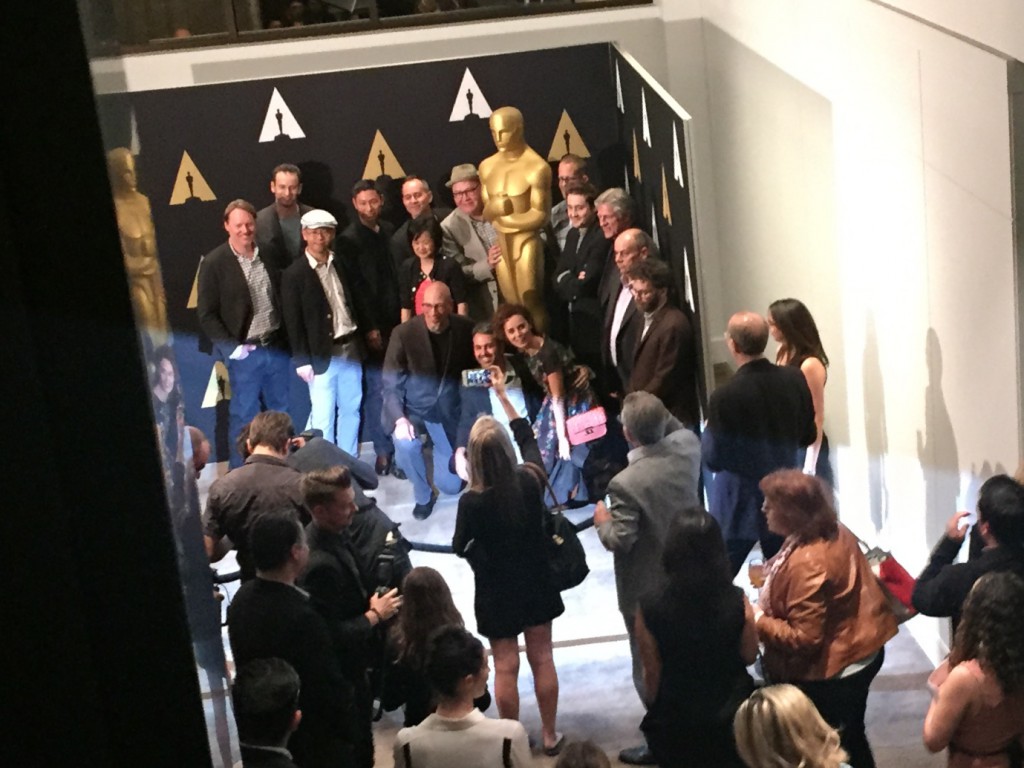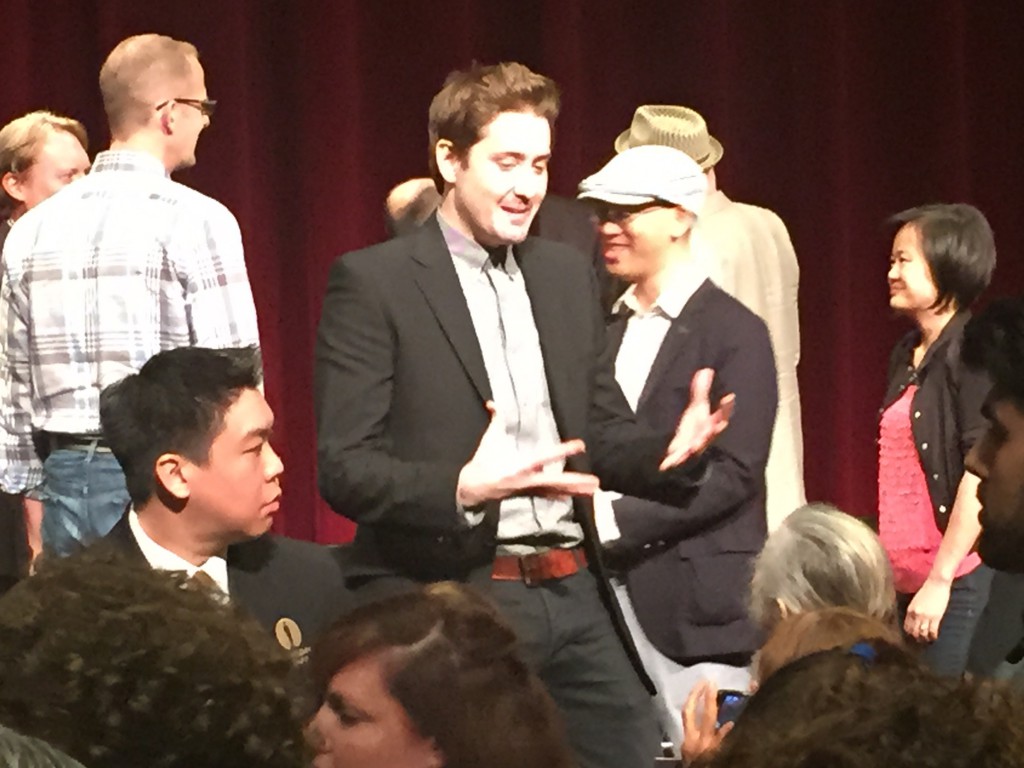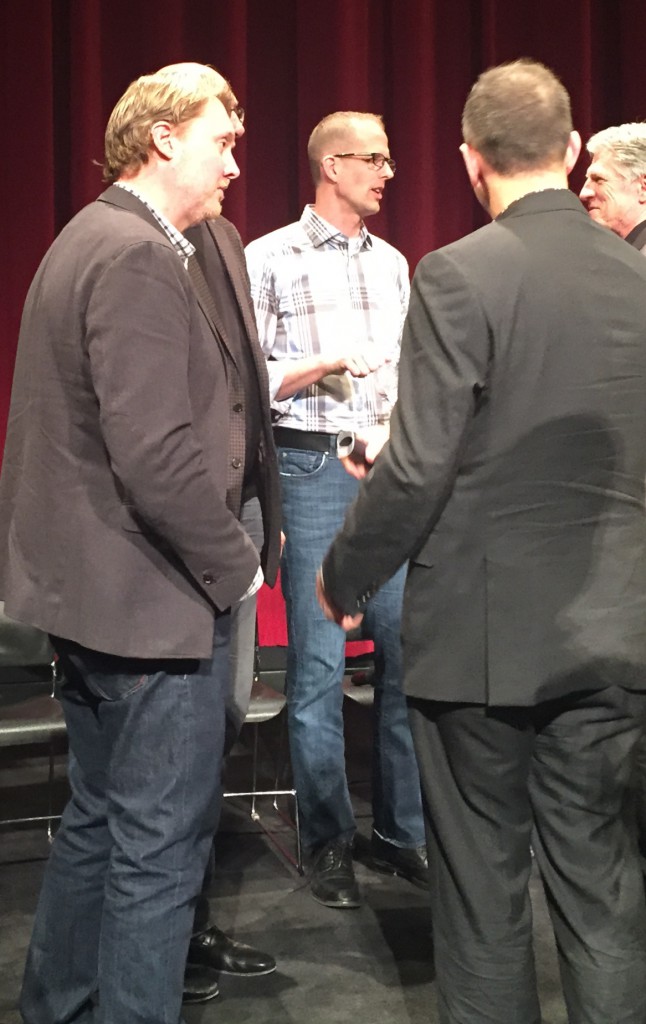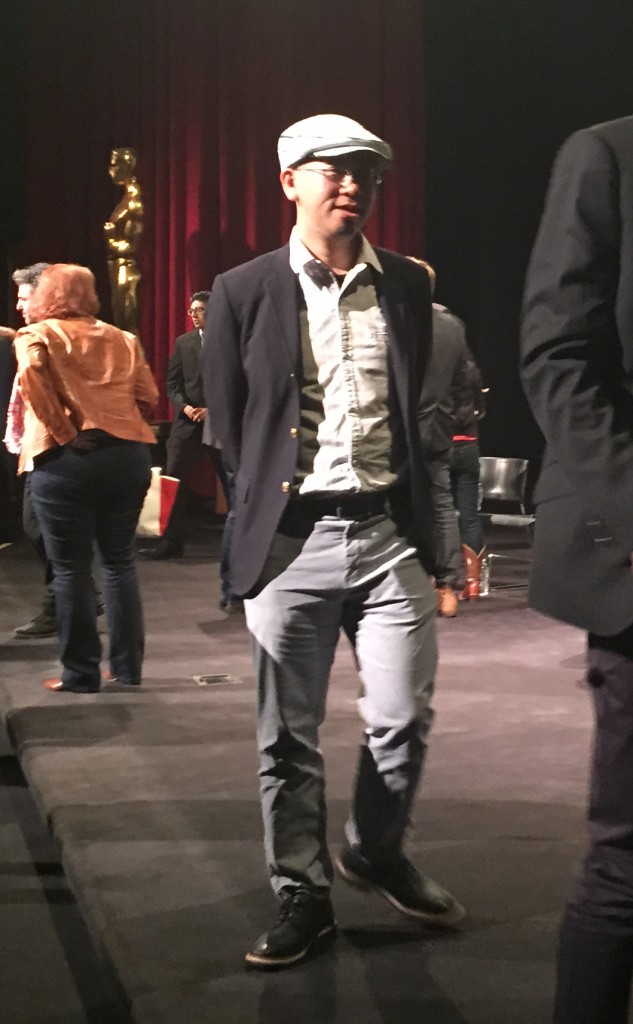The Academy Celebrates Animated Features
[gallery td_select_gallery_slide="slide" ids="142507,142508,142509,142510,142511"]
Just before the Academy Awards are handed out, the AMPAS devotes a week to programs celebrating the nominees. Producer Roy Conli and directors Don Hall and Chris Williams of last year’s winner, Big Hero 6, hosted this year’s panel devoted to Animated Features. In their opening comments, the team admitted that the Academy panel last year had been their favorite event of awards season. The vote was in, the pressure was off, and no publicists were breathing down their necks.
The evening opened with words of greeting from Academy Governor Bill Croyer. He pointed out that this year’s field illustrated the global scope of animation; ten filmmakers were there from Japan, Brazil, England… and Burbank. He also stated, “The report of the death of anything other than CG [animation] is greatly exaggerated.” Of the five nominees, two are hand drawn, two are stop motion, and only one is CG.
The nominated films were presented in alphabetical order by title. First up was Anomalisa, a stop-motion film that explores adult themes as it delineates a love affair between two disparate characters. After stating, “It really screwed me up,” one of the Big Hero 6 team pointed out that the producers of Anomalisa had also used Scott Adsit (voice of Baymax) in another of their projects.
The origin of Anomalisa was in a spoken word performance piece. Directors Charlie Kaufman and Duke Johnson were on hand with producer Rosa Tran. When asked why puppetry was selected to tell the story, Kaufman stated that film producer, Dino Stamatopoulos, was passionate about creating animated works that would explore authentic stories with more adult themes.
When asked how they achieved the subtlety of expression in their animation, the team offered a variety of responses. Actors were filmed delivering the lines for reference, a range of materials was tried out for the faceplates;and a lot of tests were made before production began.
They also sought out real people who they thought looked like the characters they had “heard” in the original performance piece. Using them as templates brought a greater sense of reality to the characters. This was not, however, a matter of rotoscope or slavish imitation. One character was actually a composite of twenty different people.
Many found the storyline of Anomalisa rather bleak. When asked abut this, the panel disclosed that even one of their own animators had to quit as he was going through a divorce at the time and found the content of one of the scenes he was working on too depressing.
Kaufman and Johnson were asked how they shared directing duties. Johnson joked, “I got the coffee.” They both went on to say that they made all decisions together with no real division of responsibilities.
Next up was writer, director and animator Ale Abreu of Boy and the World. The Brazilian filmmaker spoke through a translator for a portion of the panel. He enthused that this nomination was a great and special moment for animation in Brazil.
The inspiration for Boy and the World was somewhat unexpected. While researching another project covering 1500 years of Latin American history, Abreu came upon a photo of a boy who, he said, was “waving at me.” He set aside the history project, and extended a hand to the little boy. Hence, Boy and the World was conceived as an animated film seen not just through the eyes of a little boy, but created as if it were drawn by that little boy. It was, Abreu concluded, an exercise in freedom, to draw as a child without the critical voice of an adult.
When asked if the film reflected his personal drawing style, Abreu struggled for a moment, before saying that sometimes he felt that the little boy was actually directing the film. He did say that the film was very personal, although it was based on the history of the Latin American continent.
The moderators marveled that Abreu did all the work on this film himself. The process involved digitally printing out each scene as it was finished, then handing it over to a team to add additional texture and depth.
Music plays an important role in Boy and the World. Indeed, Abreu said he thought of the music as a character in the film—that the music was actually corporeal. In fact, according to Abreu, the music represents the father that the boy is seeking throughout the story. Musicians were involved at every stage of production, at times providing inspiration for scenes, and at other times providing immediate themes for the drawings.
A final question concerned the use of some rather intense live action images in Boy and the World. Abreu thoughtfully responded that the film is a metaphor for where we have been and where we are going. The boy moves from a garden where everything is represented through drawings alone. As he moves toward the city, collages introduce other images. The live action was necessary for an emotional change that hand drawings could not express. It was, Abreu concluded, the annihilation of the dream, illustrated through the destruction of the animation.
Director Pete Docter and producer Jonas Rivera represented Pixar’s Inside Out. A surprising admission early in the discussion is that for the filmmakers, Inside Out was very much about being parents, working out issues with their children.
When asked if the story development had been slow and steady or seismic, the reply was that it was a very consistent development, with many details that needed to be worked out. Docter stated that this process of development was his favorite part of the process. Producer Rivera said his favorite part was the animation itself—seeing the characters come to life.
The screenplay for Inside Out is also nominated for an Academy Award. The panel was asked if it had been a particular challenge to create a story from a concept that was so abstract. There was, they replied, a specific agenda. Although both love classic animation, they knew that animation could deal with bigger themes and bigger ideas. While their story had to appeal to both children and adults, they asserted that kids were smarter than we think. They chuckled that the only things that had to simplify were done so for the executives.
Asked if he had an imaginary friend like Bing Bong, Rivera admitted that his was an elephant named Norman who had a magnetic car that could drive around on his bedroom ceiling. Asked if Bing Bong was based on any particular imaginary friend, they said he was a composite of “greatest hits” from the makers of the film.
In Inside Out, Joy drives the controls of the lead character. According to the filmmakers, this was not always the case. Early in the process Fear was the major character. Joy then assisted Fear, until the writers realized this was the wrong combination: What does Fear teach Joy? The correct combination, they decided, was Joy and Sadness. As parents, we want to create joyful lives for our children, but sadness is necessary to help them deal with that most difficult constant in life, loss.
Next up in the program were Mark Burton and Richard Starzak, the writers and directors of the Sean the Sheep Movie. The first question they dealt with was how to create a new story for beloved characters that have been seen in hundreds of television episodes. What made this appropriate material for a feature film? The filmmakers explained that exploring the idea of looking at the characters as an extended family intrigued them.
For the feature, an early decision was to start in the familiar territory of the farm, and then move the characters away and into the city. One big idea was that of the missing father, in this case the farmer, who has gone away to become a celebrity hairdresser. A scary idea was to continue the tradition of no dialogue. They noted that Pixar managed to get through the first half hour of Wall-E without dialogue before they “p***ied out.”
The Sean the Sheep Movie has no dialogue. Asked if they had reviewed a lot of silent films while preparing for the film, the creators said they had indeed, and then joked that it was all deductible. They also cited the films of Jacques Tati—not silent, but with great use of sound alone in unexpected ways.
In the film, Sean the Sheep breaks out of his routine. The filmmakers were asked if this idea resonated with them, or if they were more creatures of habit. They replied that other animation studios dealt with fiery scorpions raining down, whereas they were more inclined to have a cup of tea every afternoon at 3:00. They did, however, admit that they were still figuring out aspects of the story as late as a month away from the end of production. In fact, the last storyboard was delivered just a week before the end.
The final nominated film is the latest, and possibly last, from Studio Ghibli. When Marnie Was There is adapted from a 1967 young adult novel by the British author Joan G. Robinson. The project had been on the schedule at Studio Ghibli for some time, where it was seen as a difficult property. Because much of the novel deals with the inner thoughts of the characters, director Hiromasu Yonebayashi and producer Yoshiaki Nishimura determined to tell the story through their actions and how it affected the world around them. They admitted that most of the studio’s output depicted characters who were energetic, bright and sunny—but with When Marnie Was There could tell a story of a character that was more serious.
Because the settings were such an integral part of the story, the filmmakers were asked if they based them on real locations. They replied that the marshy areas seen in the film were inspired by several locations scouted on the island of Hokkaido. To help the audience experience this atmosphere, water was treated as a major character. The film features not only the tides and rain, but also tears, as characters were seen touching water in many scenes. For animators, depicting water is quite difficult; when Studio Ghibli founder Hayao Miyazaki liked their work, they were very happy indeed.
Read more on the next page:
The discussion ended on a somber note, as the panelists addressed rumors that Studio Ghibli would not return from a hiatus that was declared in August of 2014. Tonebayashi and Nishimura confirmed that they were no longer working there, as the studio had suspended making feature films. The only output is from Miyazaki, who makes short films for the studio museum. No current plans, even whether or not the studio would operate under a different name, could be announced.
The evening was brought to a rousing conclusion as all the panelists were brought onto the stage at the same time. As the eclectic group settled in, the first question for all was whether they could recall any moments during production that were particularly amazing, wonderful, or just plain horrible.
The producers of Sean the Sheep volunteered that learning their film would be released the same year as Inside Out brought on three days of sobbing.
Ale Abreu (Boy and the World) said that the aftermath of the first audience screening was a sad moment—because the audience was so sad. After two or three sleepless nights, the decision was made to change a single sequence. Instead of a vast dump swallowing a city whole, audiences would instead see a small town blossoming. Seeing this solve the problem was when Abreu knew the film was ready.
For his reply, Jonas Rivera (Inside Out) said his saddest moment was when his four-year-old got upset when they wouldn’t let him watch Boy and the World for a second time—that day.
Next, the filmmakers were asked if their film was what they had hoped it would be. The directors of Anomalisa said it was not exactly what they had expected, as there were new discoveries every day. Pete Docter (Inside Out) said it was what he was hoping for, and much more. Jonas Rivera said that seeing Inside Out in final form late in the process pulled him through the last of the five years of labor. Hiromasa Yonebayashi (When Marnie Was There) quietly said that the image he began with and the final film were the same. “It didn’t change.”
The next question dealt with influences. Specifically, the filmmakers were asked if they could remember a film they loved that inspired them to become animators. Pete Docter admitted that he wished his was an older classic, but it was actually The Rescuers. He recalled marveling at how “cool” Madame Medusa was; knowing it was fake, but believing it was real. One of the producers of The Sean The Sheep Movie said that he saw only one cartoon a week growing up and that it was invariably a Roadrunner. Afterward, he would reenact the whole thing with a friend. The maker of Anomalisa recalled watching Tom and Jerry every day.
Ale Abreu began studying animation when he was 13. A book about Time Masters by Rene Laloux was his first text. Since he had never seen the film itself, he tried to imagine what it was about, based on the illustrations. When it finally came to Brazil years later, he invited a friend to join him in seeing it. They were the only two in the audience. The movie was nothing as he had thought it might be—so he became an animator to create the films he had imagined. Time Masters, he said, changed his life, along with Fantastic Planet by Moebius.
Tonebayashi said that it was Studio Ghibli films that inspired him, and that it was an honor to continue the tradition. He said it was very unique that one studio could produce films like his favorite, the lively My Neighbor Totoro as well as Grave of the Fireflies, full of history and nightmares.
Duke Johnson (Anomalisa) grew up loving classic theatrical cartoons like Looney Tunes. He studied filmmaking as well as created fine art. When offered an opportunity to make an animated film, he discovered that it was the perfect marriage of all his interests. Mark Burton (The Sean the Sheep Movie) said he was more influenced by comedy than animation. As a youth, he created his own British-style Kids Comics.
The final question for the group was more specific: Was there a specific moment or scene in the film of which each filmmaker was particularly proud. Jonas Rivera quickly replied that, for him, it was a quiet moment when Riley is asleep, and Joy takes a moment to view a favorite memory. As she watched Riley skating with her parents, he commented, “Man, that’s the whole movie.”
The producers of The Sean the Sheep Movie suggested that Pixar could have simply released that moment as a short, leaving the field clear for anyone else to win the Academy Award. They then went on to cite their favorite moment, the scene in which Sean is placed in an animal shelter and takes in the scene. His eyes fill the screen, and minuscule eye movements show what he is thinking and feeling.
Rosa Tran offered that her favorite moment from Anomalisa was when Lisa sings "Girls Just Wanna Have Fun." The script had called for "My Heart Will Go On," but the rights could not be secured. After trying out several songs, the actress spontaneously sang the Cyndi Lauper hit, making it just the right choice. Tran did not reveal to her animators that it took her two years to finally secure the rights to that song, even as they were animating the scene.
Duke Johnson said his personal favorite scene in Anomalisa was the rather graphic sex scene. They knew that it could have been exploitative, or inappropriately funny. Although on screen it unfolded organically, the scene itself took six months to film, and they did not know until it was screened for an audience if it would work. In the end, he concluded, audiences accepted it on its own terms.
Ale Abreu was very proud of the scene in which the boy finds the train that has taken his father away. As he searches the crowd, he slowly realizes that there are thousands of men, each of whom looks like his father.
Tonebayashi of When Marnie Was There spoke of the careful, nuanced way that Anna’s mental state was depicted. He was, he said, proud of the fact that they gently depicted the change in her character in a careful, nuanced manner. The moderators agreed that the most powerful scenes or moments in animation were so often found in silence. The program ended on that note.







